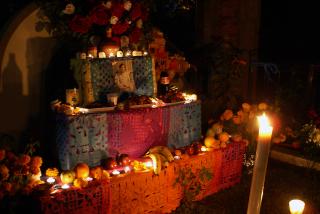
Día de los muertos (Day of the Dead) is a festive celebration in memory of those who have died. Its origins in Mesoamerica go back over 3,000 years, even though it was shaped by two Roman Catholic holidays: All Saints Day (November 1) and All Souls Day (November 2). In Spanish, All Saints Day and All Souls Day are known as El Día de Todos los Santos and El Día de los Muertos, respectively.
In southern and central Mexico, Día de los muertos entails many traditions: building private altars called ofrendas, honoring the deceased using sugar skulls, marigolds, and the favorite foods and beverages of the departed, and visiting graves with these as gifts. Visitors also leave possessions of the deceased at the graves.
Some themes: remembrance, grief, cycle of life and death, honoring those who have gone before us.

Please note that this holy day is a distinctly Mexican holiday, though some in other Latin American countries have adopted it. For that reason, it's neither respectful nor appropriate for white congregations to initiate its celebration in worship. In the words of Rev. Marisol Caballero, "When white people 'celebrate' el Día de Los Muertos not as the personal, invited guest of Mexicans, it feels to me like someone has crashed a family funeral or a wake."
To learn more about why UU congregations celebrating this day encroaches on the hurtful territory of cultural appropriation, please take the time to review the Decentering Whiteness in Worship video on this page.
This video conversation on Decentering Whiteness in Worship was recorded on September 12, 2017, between Julica Hermann de la Fuente, Glen Thomas Rideout, and Rev. Erika Hewitt.
As a matter of cultural competency, WorshipWeb encourages our Unitarian Universalist congregations to use the Spanish name "Día de los muertos," rather than translating it into "Day of the Dead" in church announcements, programs, emails, etc. There are many holidays that retain their native language (Yom Kippur, Kwanzaa, Rosh Hashanah, etc.), and we seek to make this one of them.
Please make sure to use the correct spelling of all words, which includes accents. Here's a tip for getting the í in Día:
- Windows: press Ctrl+' then the vowel (Ctrl+' then i = í)
- Mac: press Option+E, then the vowel (Option+E then i = í)
- iOS: press and hold I until a menu of accented characters appears
Toggle to filter resultsAvailable filters:
Changing a filter will refresh results (and remaining options) immediately. Searching by keyword or changing the number of items per page requires use of the "Search" button.
- Acceptance (1)
- Awe (2)
- Body (1)
- Community (2)
- Connections (2)
- Death (7)
- Ending (1)
- Family (4)
- Forgiveness (1)
- Generations (6)
- Gratitude (1)
- Grief (5)
- Healing (2)
- History (1)
- Honesty (1)
- Immanence (1)
- Interdependence (1)
- Justice (1)
- Leadership (1)
- Letting Go (3)
- Love (3)
- Meaning (1)
- Mystery (3)
- Nature (1)
- Playfulness (1)
- Progress (1)
- Purpose (2)
- Relationships (1)
- Responsibility (1)
- Reverence (1)
- Sacred (2)
- Sadness (1)
- Sorrow (2)
- Spirituality (2)
- Strength (1)
- Tradition (1)
- Truth (1)
- Wholeness (1)
- Wonder (1)
Displaying 11 - 12 of 12
-
Lighting a candle is somewhat like the beginning of life. If that is true, then perhaps extinguishing a candle is like the ending of life. But death may not be the end of us. We live on in the memories of friends and loved ones....Chalice Extinguishing | By Lee Huebert | January 21, 2015 | From WorshipWebTagged as: All Souls Day, Death, Día de los Muertos, Letting Go, Memorial Services, Mystery, Purpose, Remembrance Day, Unitarian Universalism, Wonder
-
(Tea lights are set up in groups of 50 on either side of the chancel in this ritual borrowed from Soulful Sundown.) The long Summer has faded, now, and these first days of November mark the beginning of the coming of Winter....Reading | By Christine Robinson | January 21, 2015 | From WorshipWebTagged as: All Souls Day, Community, Connections, Día de los Muertos, Family, Grief, Halloween, Letting Go, Relationships, Samhain
